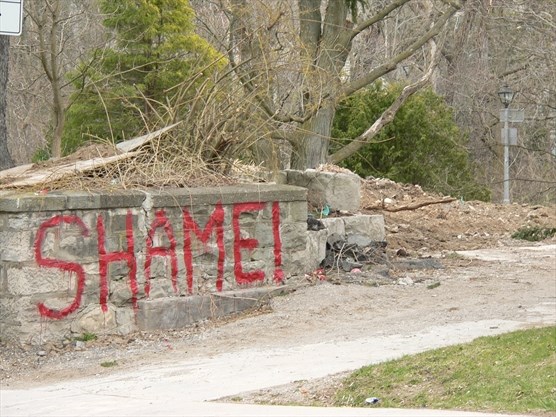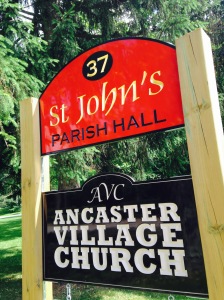
in Ancaster was demolished.
Recently I watched the video of 26 year-old Indigenous man, Seth Cardinal Dodginghorse, eloquently interrupt the ribbon cutting ceremony of the new southwest perimeter highway in Calgary. The highway is built on Tsuut’ina First Nation land, part of Treaty 7 (1877). The saga of that highway’s development has been ongoing for years — almost 70. It is not an unfamiliar story in Canada. It goes like this: City needs land, land belongs to First Nations, a tumultuous and controversial process and deal is completed, city gets land. In this case it was to build a highway. In other cases companies need land for pipelines. And as we know well from our own backyard in Six Nations of the Grand River and the town of Caledonia, it is for housing developments.
Dodginghorse remarked, “Today is not a good day.” He spoke of how his ancestor’s home was now pavement. He remembered the trails, trees, and the paths he used to know by memory — all gone. Concluding his speech in a moving gesture of mourning, agony, and respect for the land on which he stood and remembered, he cut his long dark braids off, leaving them lying on the freshly paved road. “We lived here, we grew up here, we touched this land.”
As I listened to Dodginghorse remember the land on which his mother, grandmother, and great-grandmothers were raised and led their families, only to see it paved over in the name of “progress,” my mind went to Wendell Berry’s quintessential 1968 essay entitled, A Native Hill. Berry lives, writes, and farms in Kentucky, still opting to use horses in his fields instead of tractors. Much of his writing is deeply rooted in the land: soil, trees, rocks, and streams.
In the essay Berry reflects on the seemingly unexplainable connection humans have to their home, their land. “Why should I love one place so much more than any other? What could be the meaning or use of such love?” But he notes great tensions as he reflects on his ownership and love of his land.
I am forever being crept up on and newly startled by the realization that my people established themselves here by killing or driving out the original possessors, by the awareness that people were once bought and sold here by my people, by the sense of the violence they have done to their own kind and to each other and to the earth, by the evidence of their persistent failure to serve either the place or their own community in it. I am forced, against all my hopes and inclinations, to regard the history of my people here as the progress of doom of what I value most in the world: the life and health of the earth, the peacefulness of human communities and households. And so here, in the place I love more than any other and where I have chosen among all other places to live my life, I am more painfully divided within myself than I could be in any other place.
As I read the essay I picture Berry standing at the edge of his field, gazing over what was once untouched and in an almost mystical way, pure. His reflections continue.
The difference between a path and a road is not only the obvious one. A path is little more than a habit that comes with knowledge of a place. It is a sort of ritual familiarity. As a form, it is a form of contact with a known landscape. It is not destructive. It is the perfect adaptation, through experience and familiarity, of movement to place; it obeys the natural contours; such obstacles as it meets it goes around. A road, on the other hand, even the most primitive road, embodies a resistance against the landscape. Its reason is not simply the necessity for movement, but haste. Its wish is to avoid contact with the landscape; it seeks so fas as possible to go over the country, rather than through it; its aspiration, as we see clearly in the example of our modern freeways, is to be a bridge; its tendency is to translate place into space in order to traverse it with the least effort. It is destructive, seeking to remove or destroy all obstacles in its way.
The tension of his love for the land and his recognition of what once was reads like a haunting love story, of sorts. “The thought of what was here once and is gone forever will not leave me as long as I live. It is as though I walk knee-deep in its absence.”
All of which takes me back to Dodginghorse’s words.
I remember the day I saw all the trees knocked down. These were the trees I played in, that my Tsuut’ina grandmothers played in. I knew all the trails and all the animal trails…Have you ever felt upset in your local community when one of the trees was knocked down near your house? Have you ever felt upset when one of the houses was knocked down? Now imagine your home and your history being knocked down in the name of progress…This is something that effects my family, and I need you to know that.
As I said earlier, this story of land negotiations, treaty rights, deals, and controversies is not new. It is a broken, shameful, complicated, and oft-repeated part of our colonial-settler history in this country. Again, it rages right now only a few miles from my home in Ancaster. But my intention in this writing is not to discuss who is right and who is wrong in these particular disputes, but rather as a way of reminding myself and hopefully challenging all of us to reflect and learn about these important issues. Whether settler or Indigenous, we are all treaty people.
Much space has been taken recently in the Ancaster News calling to attention the need to preserve and protect Ancaster’s history. I applaud this endeavour and those working tirelessly in support. The church which I lead contributed financially to the restoration of the Hermitage; I believe these things matter — that history and our stories matter. I, too, was upset when the Brandon House, built in 1867, was demolished. I am the chair of Ancaster Heritage Days, for crying out loud. I want to see Ancaster’s history preserved. But I cannot help but connect this issue to those similarly raised by our Indigenous neighbours. When history is erased, whether haphazardly or in the name of progress, we hurt. We get angry. We feel loss. It does not matter if you are a settler or Indigenous, we all carry with us a connection to the land, our history, and our stories. Yet for me and my fellow settlers, we too often forget that our history is not the first history here. And that our development, even back in 1867, was made on someone else’s land. Treaty 3 (1792) land, to be exact. The agreement in that treaty, which stands still today, was that the king’s subjects would have free unhindered travel and be able to make roads through this territory. And in knowing that I cannot help but hear the words of Berry and Dodginghourse. I do not think it is a stretch to say that we have built considerably more than just roads. And so it is that Indigenous peoples on these lands have lived through generations of watching trees cut down and land developed, and each time I know a little bit of their history is erased — the connection to the their land severed.
As we work to remember and safeguard the history of Ancaster, let us not forget that we should owe the same commitment to our Indigenous hosts. Let us commit to learning about our treaties, land claims, and the tensions which exist today. And let us build bridges with our Indigenous neighbours, working towards reconciliation and justice. Their story is deeply connected to ours. And we all share this land.
Rev. Aaron D. Gerrard
Settler & Pastor, Ancaster Village Church


